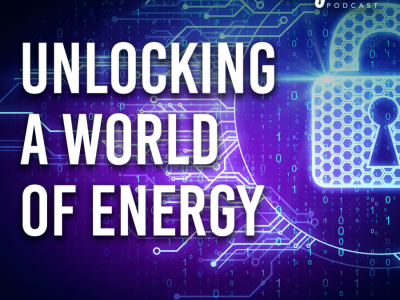Green stormwater infrastructure uses the power of plants and soils to improve water quality. More than that, Lauren McPhillips discusses how making stormwater infrastructure green is saving cities money, impacting environmental justice, and cooling urban heat islands with aesthetically pleasing gardens.
Transcript
INTRO: You know, a lot of these more traditional strategies were solving one problem and causing another problem. By efficiently conveying stormwater down in our sewer systems, we were basically moving the problem downstream. We didn't have as much flooding in our street, but now we're effectively shunting it down to the stream that's now flooding and eroding. And so it was kind of like we're just moving the problem down to the next community.
HOST: Welcome to Growing Impact, a podcast by the Institutes of Energy and the Environment at Penn State. Growing Impact explores cutting-edge projects of researchers and scientists who are solving some of the world's most challenging energy and environmental issues or raising awareness of these issues. Each project has been funded through an innovative seed grant program that is facilitated through IEE. I'm your host, Kevin Sliman. Today, we speak with Lauren McPhillips and her work with sustainable stormwater.
HOST: So welcome to Growing Impact. Today on our episode, we are featuring Lauren McPhillips and her seed grant, “Identifying Sweet Spots for Green Stormwater Infrastructure Interventions in Pennsylvania Urban Communities.” Welcome, Lauren, to the show.
Lauren McPhillips (LM): Thanks, Glad to be here, Kevin.
HOST: So, can you talk to me just about green stormwater? Because when I hear green, I think of algae and I think negatives, but I think in this case, right, green is a positive thing.
LM: People also have the connotation too about like green being sort of low impact and, and like renewable energy. And so there's always a lot of lingo challenges and people use it a lot of different words to describe sort of sustainable stormwater management. A word that I personally like to use, and that a lot of municipalities in our area tend to use is this idea of green infrastructure, green stormwater infrastructure. And the idea is, the sort of counterpart is gray infrastructure—the idea of more sort of hard pipe, concrete and metal-based structures that are mostly providing one function, maybe two functions focused on like conveying or storing stormwater. Where the idea of green stormwater infrastructure is leveraging the power of ecology and plants and soils to help provide additional benefits, on the water quality side, but also the aesthetic side and other sorts of ecosystem services or benefits.
HOST: Lauren says that while cities are starting to recognize the importance of green stormwater, infrastructure, progress has been limited.
LM: Yeah, so the idea behind this was that a lot of municipalities, organizations at different levels are trying to start implementing these green infrastructure strategies. And a lot of times it seems to be happening kind of piecemeal. Increasingly, there are more overarching plans trying to think more holistically about how to better strategize and locate these features. But a lot of that might be limited by funding. And so it's kinda happening in a lot of cases more opportunistically where maybe utilities need to be replaced and something needs to be dug up and so okay, we may as well put in a bioswale here. And so the idea here was to try to help communities think about planning more holistically and integrating not just sort of the hydrology and water side of things, but also trying to consider these other factors that, that we should be thinking about. Especially on the equity side, thinking about who's getting access to the benefits from these features. So we tried to bring in, you know, kinda leverage the power of all this geospatial data that exists on like, you know, the vegetation that's there. Thinking about where are there parts of the city that don't have much vegetation, thinking about where are the most vulnerable sort of communities living, and trying to put all these layers together and help cities sort of optimize where they might get the most benefit out of putting in some of these new green stormwater infrastructure features.
HOST: So why shouldn't the city do this? I mean, really, I mean, if it is cheaper for me to put concrete down, and a pipe down and it’s more efficient, why should the municipality consider green stormwater?
LM: Yeah, So, some are definitely still pushing against this concept because it's like, well, existing infrastructure has worked well in some ways and we're good at it and, it can be seen as more cost-effective. But honestly, when you start adding in these additional benefits that you're getting out of green infrastructure, they start to become a more cost-effective solution because it's like you're solving multiple goals with one sort of strategy. And a lot of cities are starting to recognize that. They’re recognizing that—A lot of these more traditional strategies too were solving one problem and causing another problem by efficiently conveying stormwater down in our sewer systems, we were basically moving the problem downstream. We didn't have as much flooding in our street, but now we're effectively shunting it down to the stream that's now flooding and eroding. And so it was kinda like we're just moving the problem down to the next community. And so it's kind of these different, these multiple different factors that are, that are converging and making cities starting to get more excited about this concept.
HOST: Lauren says there are three clear benefits to green stormwater infrastructure.
LM: One thing for sure is improvement in water quality here in the Chesapeake Bay. We're mandated to think about managing nutrients. And a lot of times we think about agriculture as, you know, one source of nutrient issues. But cities are also tasked with trying to find ways to manage their nitrogen and phosphorus and they are still a source of that. And so by integrating these ecological features in these green stormwater infrastructures, you can get better water quality treatment in the stormwater that's moving through them. And so that's definitely something of interest. Another potential benefit is helping to manage the urban heat island. So by having, you know, some of these features may have shrubs or trees on them. So you're getting some evapotranspiration that's providing cooling as well as potentially shading if you're getting trees. And so that's helping to manage the urban heat island that's created by just having all of this sort of hard, dark impervious surface at the core of a lot of our older cities here in Pennsylvania. And then another thing too is just the sort of aesthetic benefits too. It's nice to see, you know, there's a lot of consideration of the type of plants that are going in these trying to pick ones that would not require a ton of maintenance, can help with these sort of water quality functions, but also look nice as well, might be flowering at different parts of the year or just could even actually attract pollinators and provide little, little islands of habitat in the city.
HOST: How does an interdisciplinary team benefit from this kind of complicated process of green stormwater infrastructure?
LM: Yeah, just because of the different sorts of data and considerations we're trying to integrate in this sort of multi-goal planning process here, it required having people from a lot of different domains, I think that's why this was a really nice project to see supported under the seed grant program because it helped us pull together people from a lot of different departments, colleges and even campuses at Penn State. And so we've had to think about the social vulnerability side, thinking about how to characterize what parts of cities are these communities that are, have kind of been historically underserved in different ways. And so folks that are the expert on that side and on the ethics side of things, as well as someone on the economic side who can help us think about the questions that sort of practical feasibility, what sort of types of property are good for this sort of work. And then some collaborators more on the water and the engineering side and even on the landscape architecture side. So we kinda cover a wide range of disciplines.
HOST: One interdisciplinary component of this project is a survey that aims to understand what is valued by the people of Lancaster, Pennsylvania, the city with Lauren and her team are working.
LM: One part of it too, is a survey to actually try to get the perspective of people that live in Lancaster or visit Lancaster on how to prioritize these different factors. Because obviously we could weight them equally and say all these things are important. But we could also choose to weight things more heavily for certain factors. And so we're actually about to launch a survey in Lancaster that will help get the perspective of community members on what they think should be important in this planning process.
HOST: Some of the same researchers who have worked with Lauren on this project are also helping to build a living lab at Penn State to be used as a stormwater education and outreach tool.
LM: Penn State has been supporting some additional seed grants at the university level as part of its strategic planning process. And so some of my collaborators on this same grant, in particular, Hong Wu from Landscape Architecture at Penn State, led this project that we call our living lab for green stormwater infrastructure. And it is mostly centered around Penn State in terms of leveraging the green stormwater infrastructure that we have on our campuses as sort of a research and education tool in our classes and in student research projects. And so that's been something where we've been engaging and monitoring and fieldwork and surveys on campus to kinda characterize all these multiple benefits that I was talking about. But a key part of this too is also enhancing our connections and our sort of knowledge transfer with Pennsylvania community.
HOST: Thank you to Lauren McPhillips for being with us today on Growing Impact. And we were speaking about her seed grant, “Identifying Sweet Spots for Green Stormwater Infrastructure Interventions in Pennsylvania Urban Communities.” Thank you so much for being here.
LM: No problem. Glad to talk about this fun project that we've had the great opportunity to work on.
HOST: You've been listening to Growing Impact, a podcast by the Institutes of Energy and the Environment at Penn State. I've been your host, Kevin Sliman. This has been season 1, episode 2. Thank you for listening.








